Defining Needs Up Front Key to Successful Integration of Command Training Center into a Department
By Larry L. Collins
Best known as Florida’s Space Coast, Brevard County is roughly 35 miles east of Orlando on the Atlantic Ocean. With a population of more than 550,000 residents, Brevard County is home to the Kennedy Space Center; Cape Canaveral Air Force Station; Patrick Air Force Base; world famous Cocoa Beach; and Port Canaveral, the second busiest cruise port in the world.
Brevard County Fire Rescue (BCFR) provides comprehensive all-risk fire and emergency services to a diverse urban-suburban-rural mixed county, the 10th largest in Florida. The department covers more than 1,000 square miles, including 72 miles of beaches. It is comprised of 31 fire/EMS stations organized across five districts/battalions; BCFR employs 550 full-time members, plus another roughly 200 part-time fire reservists and volunteer members. The protection area includes residential, commercial, high-rise, industrial, airports, beaches, and wildland-urban interface. The department responds to more than 100,000 incidents per year.
Clearly, one of the biggest challenges facing BCFR is the geography of the area it serves. Given the county’s size, it is difficult for the department to bring crews together at a centralized location for joint training on a regular basis–the travel time alone for some companies eats up available training time. Hence, these sessions occur only a few times per year. Furthermore, as a result of geography, the department has a tendency operationally to split into three groupings: Northern Brevard, Central Brevard, and Southern Brevard. This results in each geographical area taking on its own identity and its own ways of doing things. To get everyone “on the same page,” particularly as it pertains to the command system, it was crucial to develop a training regimen that provides consistent ways of safely communicating, arriving, and acting at an incident scene. In addition, we needed a program that used modern technology to allow a great deal of the training to take place in the station and that appealed to today’s firefighters; that provided an established, tried, and respected curriculum; and that provided the opportunity for personnel to train in a hands-on fashion with the system. Given these parameters, we naturally began exploring the various command simulation programs currently on the market.
Much has been written regarding the benefits of fireground command simulation training, but how does a department go about selecting such a system? Ultimately, BCFR chose the Blue Card Command Certification model; however, regardless of the simulation package selected, the key to successfully integrating a command training center into the department is defining your needs up front and then comparing the various systems now on the market to determines which meets those needs best. Below are some of the more significant needs BCFR identified in its search for a command simulation training program.
Blue Card Program Provides Foundation
BCFR looked at a number of command simulation programs before deciding on the Blue Card program. The Blue Card curriculum serves as the department’s basic incident management foundation, unifying and formalizing critical command components into an easy-to-apply and functional management system that seamlessly expands and contracts as each situation dictates. However, it has also been designed for customization and adoption by departments at the local level. BCFR has made some of those modifications by blending Blue Card with parts of our existing standard operating guidelines (SOGs). The ability to integrate the two components (a functional management system with our need for minor customization) without a loss in the basic command philosophy was critical for us. In addition to our expected return on investment in areas such as improved command and control techniques, decision making, clear and concise communications, and the all-important improvement of incident scene safety that simulation training provides, other key points leading BCFR to the Blue Card model included the following:
- A standardized curriculum. This was a critical element for us. It was highly important from the administration’s perspective that each member got the same consistent information in the same consistent format and that the program was based on a well-recognized command system, ideally one that was National Incident Management System (NIMS)-compliant. Blue Card, which is based on Chief (Ret.) Alan Brunacini’s Fireground Command System, arguably the most recognized and most widely used command system in the world. It addresses the NIMS Hazard Zone Type 4 and 5 local incidents and dovetails seamlessly with Hazard Zone 1, 2, and 3 situations (federal, state, and regional). From wildland and hurricane perspectives, for example, we wanted to be able to take our everyday command system and ensure it flowed naturally into the more complex incidents involving state and federal assets.
- Computerized delivery. Given the size of our county (72 miles long), it was important that we be able to deliver the same cognitive content without having to move crews long distances every day to do it. The initial portion of Blue Card is Web based. Personnel complete the training online in the station each day (they are given 90 days to complete the online training). The program requires a 50-hour didactic and interactive classroom segment that includes not only video lectures and interactive exercises but also quizzes at strategic points in the program to reinforce key points, check student progress, and provide them with instant feedback on their progress. An unexpected benefit we discovered was that Blue Card maintains and tracks a separate training record for each student that includes each time they log into the program. This enables us to easily monitor and record student progress. The quality of the content is on a par with, if not slightly above, many of the better online university classes being taught today. An important feature we found was that students cannot skip ahead in the program–one must successfully complete each item before the program allows the student to move on. In that regard, it may actually be “firefighter proof.” Finally, it is delivered using technology that today’s firefighters adapt to well to and learn best from. The Gen Xers and Millennials (Gen Y), a large portion of our personnel today, do a much better job learning from this type of interactive technology than the basic lecture most Baby Boomers are accustomed to.
- Demonstrated knowledge and learning. The system requires three full days in the Command Training Center (CTC) where students learn and demonstrate their ability to apply the concepts gained through the online segment of the program. The program has a positive learning curve in that students actually learn more than for which they are tested at the CTC. If you get it wrong, you just go back and do it again and again until you get it right. In that sense, the CTC is a learning center far more than a testing center. The nature of the simulations and the repetition involved under highly realistic conditions provides the student with a level of confidence they could only otherwise gain by actually completing such tasks on the fireground. In some instances, as we all well know, this may take years as opposed to days. The experience gained is invaluable.
- Certification. We want our personnel to be able to walk away with not only the experience and knowledge gained from the program but also with a meaningful sense of pride regarding their accomplishment. This is no rubber-stamp program, and formal recognition for its completion is warranted. Because the program is based on the Hazard Zone Incident Command Standard (2009 edition) and was adopted by the (International Fire Service Accreditation Congress (IFSAC) Alternative Standards Council, some college fire science/administration programs are actually offering up to eight upper-level credits for completion of the overall program.
- Credible instructors. Certified Blue Card instructors are the only individuals authorized to certify students as Blue Card incident commanders (ICs). The program keeps tight control over this. After receiving their own certification, a certified Blue Card instructor spends an additional three days of training (from the founders of the program) where they learning how to teach, manage, and conduct the classroom and simulation portions of the program. The Blue Card program is only as good as its instructors; we made certain they were top shelf before we invested in the program.
- Continued support. The program also offers continuing education modules. Students must recertify every three years to maintain their certification. This includes completing 36 hours of continuing education units over that time period. A program subscription provides 12 hours annually of online continuing education tactical training, plus a quarterly newsletter discussing emerging trends, techniques, and issues within the fire service.
- It‘s cost effective. Very few departments have spare change lying around these days for the purchase of elaborate toys and programs. BCFR certainly does not. When we did the math, we found that we could provide this training and certification to all of our officers and chiefs for roughly the same amount of money we would have to pay for their tuition at a state-sponsored university had they taken this program there. We also found it cheaper, quicker from a program-delivery perspective, and actually far more consistent in terms of content delivery than if we were to pay the in-house staff hours to do the didactic portion. Personnel are also able to accomplish a large portion of the computer work in the station, where they remain available to respond as needed. For us, this all spelled value.
BCFR Command Training Center (CTC)
Although the online command training serves as an important learning foundation, the practical learning takes place in the simulation laboratory (Sim Lab), where students manage roughly 100 different high-quality incident simulations over a three-day period. We try to keep class size at around 10-12 students. The CTC provides the location where each officer comes to demonstrate a thorough grasp of the eight standard functions of command outlined in the Blue Card curriculum. Thereafter, members report to the Sim Lab for ongoing command training based on internally developed scenarios using local structures and common conditions while still applying the Blue Card Command concepts to the various situations encountered. As we previously noted, the ability to train using local hazards and situations was extremely important. The CTC at BCFR is comprised of several components, each interconnected and designed to provide the most realistic environment possible for a maximum learning outcome. The elements include the CTC classroom, the control room and dispatch center, the Strategic IC (DC) command response vehicle, company level officer positions (computer kiosks), and the mobile command unit.
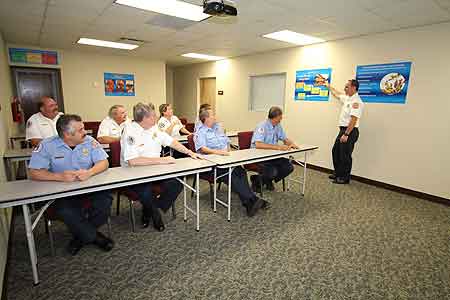
(1) A look inside the CTC classroom.
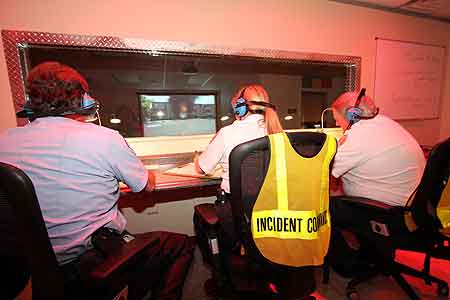
(2) The mobile command vehicle.
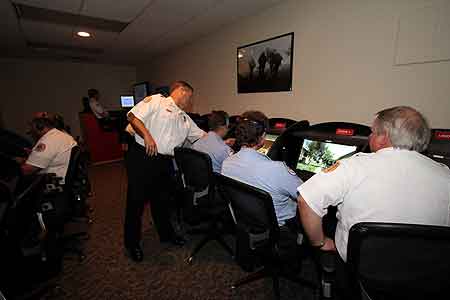
(3) Personnel train at kiosks.
Classroom
There is a dedicated classroom in the CTC. All simulations begin here with a review of each program’s content, objectives, critical incident factors, and so on. Once the review is completed, students do “sets and reps,” which essentially are dry runs for various types of incidents they will encounter in the lab. An incident picture is projected on the screen for everyone to work from. Each student is assigned to a functional position in the dry run, as they eventually will be in the lab: Engine 1 is the fast-attacking IC; Engine 2 is the commander; Engine 3 is commander; Ladder 1 is commander; DC1 is the Strategic IC… The sets and reps help the students to relax and develop a flow before actually getting into the lab simulations. Most simulations also end here with instructor-led post-scenario critiques by the group.
Control and Dispatch Center
Clear, concise, accurate communications among operating units is a necessary component for the successful resolution of most incidents to which we respond. Dispatchers play a vital role in that communications chain; consequently, we added an actual dispatch console with software that matches those in our communication center so that our dispatchers are trained in the system and their particular role in it. In this same room is an instructor’s console from which event simulations are built and controlled. The system uses Fire Studio 5 Software from Digital Combustion and has a master control console for coordinating among all of the responding units in the scenario.

(4) The simulation lab.

(5) Training at Engine 1.
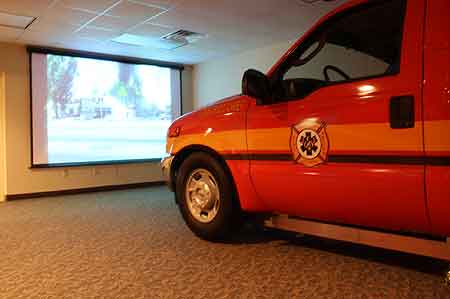
(6) The district command vehicle.
District Command Vehicle
The district command vehicle is an actual fire vehicle cab taken from a surplus department rescue vehicle. It has all the normal functioning command equipment (mobile radio, headsets, mobile data terminals (MDTs)) found in the department’s front line district chief command response vehicles. The vehicle faces a large projection screen where the incident scenario is played for the responding strategic IC. It is in a separate room from the responding fire companies.
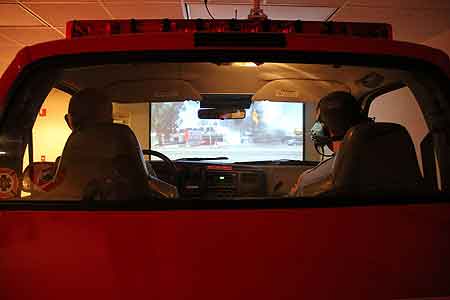
(7) The view from inside the district vehicle.
Company-Level Officer Positions
These are essentially computer work stations (kiosks) for the officers of responding companies to work at. Each work station has a computer, screen, mouse, keyboard, and radio with a headset. Depending on the assignment, each position sees a different perspective of the fireground operation, like at an actual scene, making the ability to communicate effectively over the radio critical to the overall operation.
Mobile Command Vehicle
When an incident expands beyond a full first-alarm assignment, the strategic IC moves into the mobile command unit (MCU), forms a command team, and continues to manage the incident. Like the district command vehicle, the MCU faces a large projection screen where the incident scenario is played for the command team. It, too, is in a separate room from the responding fire companies. The command team consists of the IC, a support officer (command tech), and a senior advisor. There are also work stations within the vehicle for the logistics, safety, and public information officers. The command team sits together at a console complete with tactics boards, radios, headsets, MDTs and views the operation through a large window on the side of the vehicle.
**
As part of the training initiative, BCFR is putting all of its chief and company officers (around 150 personnel) through the entire certification process. All line firefighters and support staff receive the first responder module to ensure a basic understanding of the system. And although not all members are completely through with the entire program at present, BCFR is already seeing positive results from its investment in a CTC and the Blue Card program. Responding chief and company officers are better prepared to tackle common emergencies and do so with confidence and a high level of poise. Incident decision making has improved, incident outcomes are consistently more positive overall, and fireground communications are concise and significantly improved. Overall, our personnel enjoy the training and look forward to their time in the Sim Lab. The training has a serious practical application that they truly appreciate.
We found that the key to a successful CTC is to define in advance what the goals of such an undertaking will be. CTCs do not need to be as elaborate as the one described above to be effective; they do, however, require a well-defined and thought-out curriculum on which to base the training if it is going to be truly successful across the department. They also require a software package that’s realistic, well-supported, and fairly easy to use when developing local scenarios. All-in-all, a little preplanning and investigation will go a long way in selecting a program that fits the needs of each department or, better yet, of each region.
Larry L. Collins is a 34-year veteran of the fire service. He is the fire chief for the Brevard County (FL) Fire Rescue Department. He began his fire service career as a cadet firefighter in the Harrison (OH) Township Fire Department, a volunteer fire department and began his career as a paid firefighter with the Dayton (OH) Fire Department in 1978, where he served as chief for 11 years until he retired in 2008 after 30 years of service. He is an Ohio-certified fire safety inspector, state fire instructor, certified EMT-B, and a level II firefighter and a Florida-certified level II firefighter. He holds an associate degree in fire rescue administration, a bachelor’s degree in public safety management, and a master’s degree in operations management (with a business concentration) from the University of Arkansas.

